Multiple plots
To print 4 histograms (with 100 classes) of random normal distribution samples on the same plot, where n=351, mean=160, sd=6.03:
> par(mfrow=c(2,2))
> for (i in 1:4){
hist(rnorm(351, 160, 6.03), 100)
}
Gives the following plot (yours may differ because of randomness):
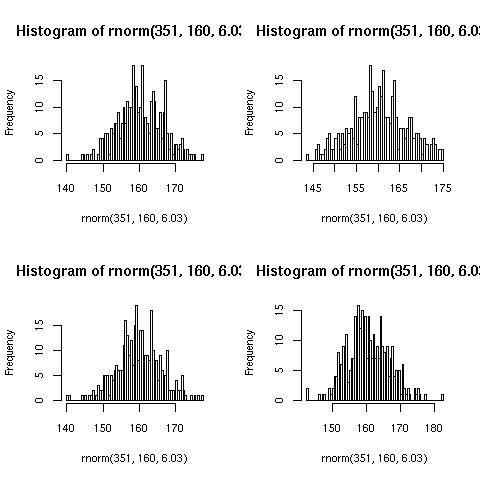
To produce a jpeg:
> jpeg("~/multiplot.jpg")
> par(mfrow=c(3,3))
> for (i in 1:9){
hist(rnorm(351, 160, 6.03), 100)
}
> dev.off()
Which produces the following image:
 Note:
Note: The dimensions of the image are 480x480 pixels, hence the titles being truncated. The following is more appropriate:
> jpeg("~/multiplot.jpg", 600, 600)
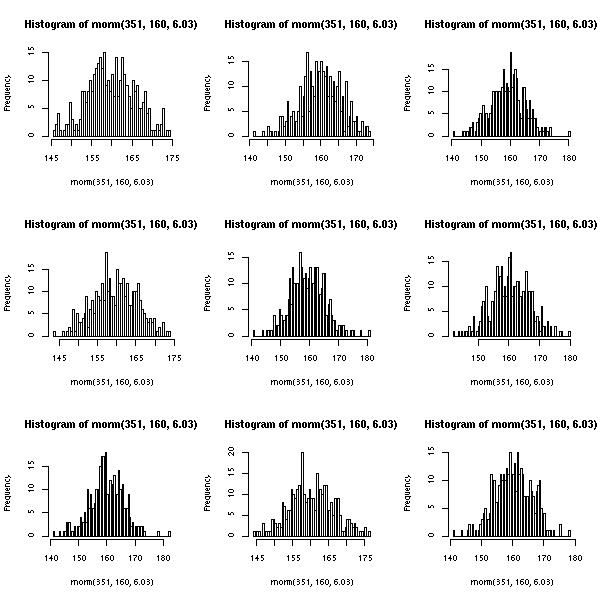
Cumalative plot
coal.txt contains the interval in days between successive mine explosions. The following command can be used to produce a cumulative plot:
> x<-scan("coal.txt") //read data
> time<-cumsum(x) //cumulative 'running' sum of the data
> number<-1:length(x) //sequence from 1:190
> plot(time, number) //giving:

> scatter.smooth(x=time, y=number) //or a scatter with smoothed curve overlay:
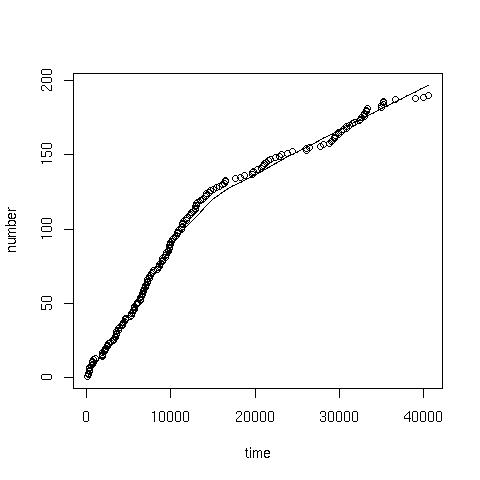
Poisson distribution
To plot a poisson probability function Poission(mu) from the data in
dec20.txt, issue the following commands:
> dec20<-scan("dec20.txt") //load in data
> barplot(dpois(1:max(dec20),summary(dec20)['Mean'])) //prints the following:
 Note:
Note: the syntax to get the mean from the summary is not straight forward. Because
summary(...) returns an atomic vector, hence the
$ notation cannot be used to (de-)reference the internals of the returned data structure, like it can from say
hist(x,y)$counts. The array syntax
[] should be used, hence:
summary(dec20)['Mean'] to get hold of the mean/mu. You might find it enlightening to issue the following commands:
mode(summary(dec20)),
mode(hist(x)) to get a feel for the different data structures returned from various functions. You might also like to try
attributes(...).
Histograms
> hist(dec20) //plots the following
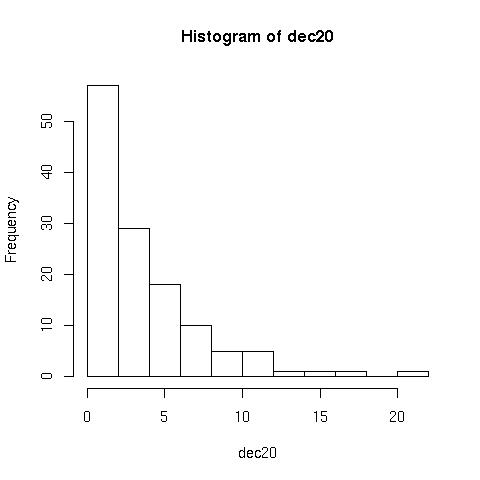
But can be improved with the following:
> hist(dec20, 23, right=F)
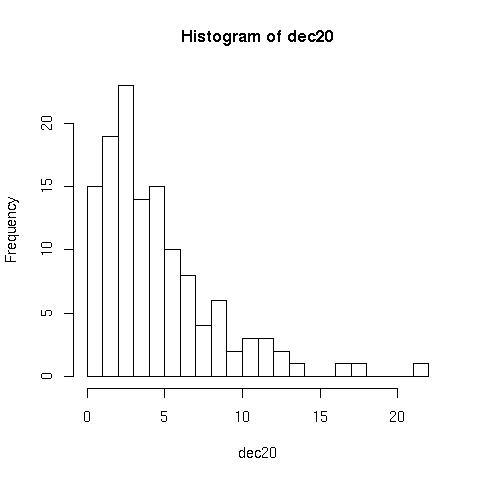
Notice that the second plot has more groups/classes, and the frequency for 0 is now plotted separately,
right=F.
Poisson process
earth.txt contains intervals in days between major earthquakes.
> e<-scan("earth.txt")
The following finds the probability that exactly 5 earthquakes happen in a typical 4 year period:
> dpois(5,((365*3)+366)/summary(e)['Mean'])
And the following finds the probability that fewer than 3 earthquakes happen in a 4 year period:
> ppois(2,((365*3)+366)/summary(e)['Mean'])
The waiting times between successive earthquakes can be described through an exponential distribution, with parameter lambda (rate, number of earthquakes a day).
The probability that the waiting time will be less than the 30 days:
> pexp(30, 62/27107)
and will exceed two years:
> 1-pexp(2*365, 62/27107)
Quantiles for an exponential distribution
The mean of the interval between serious earthquakes is 437 days (see above for data). The median can be calculated using P(X<= x)=0.5:
> qexp(.5, 1/437)
which results in approx 303 days. 1/437 is the rate of earthquakes (1/mu). Any quantile can be calculated in this manner.
Cycling accident data for 2005
See also:
Times online,
Gov Direct,
Repackaged csv.
Load the following file
2005.csv
> stuff<-scan("2005.csv", skip=1, what=list(year=0,north=0, east=0), sep=',', quiet=T)
Create a density plot of the co-ordinate data (densities are calculated over a 500x500 grid):
> blah<-kde2d(stuff$north, stuff$east, n=500)
blah is a list containing 3 items,
x and
y, representing the grid, and
z a 500x500 matrix containing the kernel density for each cell in the grid:
Then plot the result:
> image(blah, col=c(0, rainbow(50)))
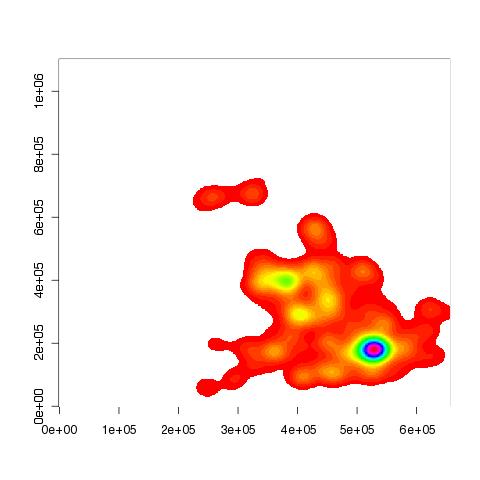
You can see that the above plot is a lot clearer than the following:
> plot(stuff$north, stuff$east)

If you want to add a colour legend to the z-plot above, you'll need to install the
fields package:
> install.packages("fields")
> library(fields)
> image.plot(blah, col=c(0, rainbow(50)))
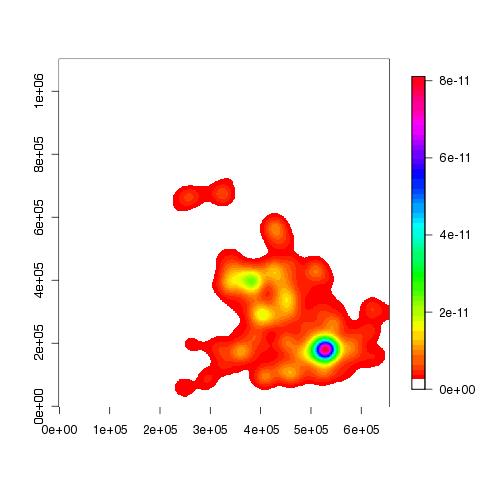
To add a few place names...
> points(537500, 169500);text(537500, 169500, pos=2,"Beckenham");points(534500,184500);text(534500,184500, pos=2, "Hackney");points(532108,178763);text(532108,178763, pos=2, "E&C")
> points(531496,181359)
> text(531496,181359, "Shoe Lane (The City)", pos=4)
The following plot show the accident hotspot for London in 2005 was approximately in the region of Shoe Lane:

and Victoria Emabankment in 2007:
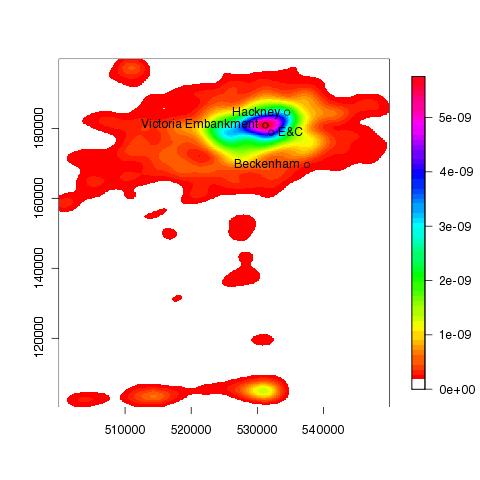
TODO nice to add UK boundary to the plots.
Testing the central limit theorem
I wanted to test that the mean over a large number of samples can be modeled adequately with a normal distribution.
Further, I wanted to see if the theorem held up when the original distribution was heavily skew.
To investigate:
means<-numeric(10000) //somewhere to store the means
for(i in 1:10000){means[i]<-mean(rbinom(n=10000, prob=.1, size=5))} //generate 10000 random binomial distributions, storing each of their means, note I use prob=.1 producing a heavily skew distribution
h<-hist(means) //plot the distribution
Now lets overlay the idealised normal curve.
x<-seq(0.4766, 0.5262,.0001) //generate the x values, use range(means)
y<-dnorm(x,mean=mean(means),sd(means))*.005*10000 //scale the y values by the bin width and the number of samples (look at the =h= for bin width).

Normal approximation looks pretty good.
And the probabilty plot looks like this:
plot(sort(means), qnorm(seq(1/10000, 1,1/10000)))
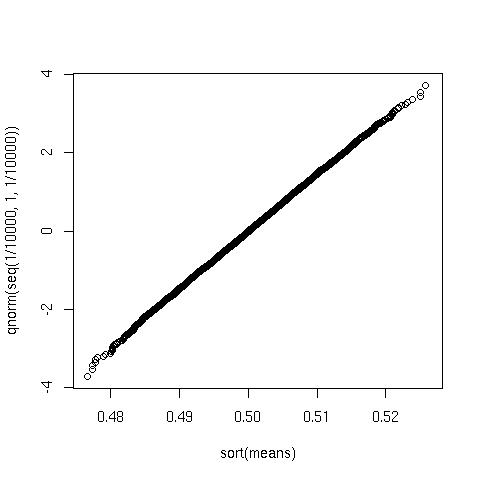
Again looks very good.
Data frames and Combinations
Create a list containing two columns with a count form 1 to 31
L<-list(A=c(1:31),B=c(1:31))
Create a data frame that contains all the combinations 1 to 31
G<-expand.grid(L)
Add a column, excel style:
G$fraction <- G$A/G$B
Filter by column:
G[G$fraction <= 1,]
Count the number of rows of a dataframe:
nrow (G[G$fraction <= 1,])
to top
 To produce a jpeg:
To produce a jpeg:
 Note: The dimensions of the image are 480x480 pixels, hence the titles being truncated. The following is more appropriate:
Note: The dimensions of the image are 480x480 pixels, hence the titles being truncated. The following is more appropriate:



 Note: the syntax to get the mean from the summary is not straight forward. Because
Note: the syntax to get the mean from the summary is not straight forward. Because  But can be improved with the following:
But can be improved with the following:
 Notice that the second plot has more groups/classes, and the frequency for 0 is now plotted separately,
Notice that the second plot has more groups/classes, and the frequency for 0 is now plotted separately,  You can see that the above plot is a lot clearer than the following:
You can see that the above plot is a lot clearer than the following:


 and Victoria Emabankment in 2007:
and Victoria Emabankment in 2007:

 Normal approximation looks pretty good.
And the probabilty plot looks like this:
Normal approximation looks pretty good.
And the probabilty plot looks like this:
 Again looks very good.
Again looks very good.